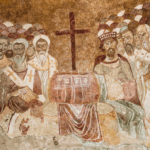This is a theological reflection to accompany this letter regarding the role of miracles in the life of modern Christians. Keen readers might benefit from considering both.
Leaders in the Word of Faith movement such as Bill Johnston, Kenneth Copeland and Todd White have come under fire for saying that the earthly Jesus was just a man empowered by the Holy Spirit—and that, because of that fact, we should be able to do the same things he did.
Leaders in the Word of Faith movement say Jesus was just a man empowered by the Holy Spirit—and that we should be able to do the same things he did.
Evangelical and reformed critics have said this is heresy—the Bible and orthodoxy insist that Jesus was both God and man. Jesus was able to do what he did because he was God the Son.
This is a fraught issue and, from what I’ve read, there is right, wrong, misunderstanding and imprecision on both sides. In this post I would like to lay down seven principles to try to build up a more complete picture.
Principle 1: Jesus never stopped being God.
One theory—known as kenosis Christology[1] imagines that the incarnation involved Jesus leaving his divinity behind for a while and living solely as a man.
If there was ever a moment when God the Son stepped aside from his divinity then he was never God in the first place.
We must reject this. If there was ever a moment when God the Son stepped aside from his divinity; if it was possible for him to stop sustaining the universe by the word of his power; if there was a fraction of a second when the Trinity was reduced to a Binity—then he was never God in the first place.
The Trinity is not a trio of gods who might tag-in or tag-out like a wrestling troop. It is God the Father working through his Living Word and Living Spirit. It is God together with his (mysteriously personal) Glory and Love. The three persons of the Trinity are not just equal, they are inseparable. Without the Son there is no Father; without the Father and Spirit there is no Son. Neither the incarnation nor the death of Jesus undid this fundamental reality.
Principle 2. Jesus was not a hybrid.
A number of other theories—sometimes labelled Monophysitism or Eutychianism—try to preserve Jesus’ divine nature by having it operating inside his humanity.
We should reject this too. To say that God the Son never stopped being God, does not mean that his divine nature was lurking inside his human nature—as if baby Jesus was secretly sustaining the universe from somewhere inside his skull. This is to confuse the natures of Jesus.
Jesus the man was just that—a man: flesh, blood, body and soul. When he did his miracles, he did them the way other humans do them—through the power of God’s Spirit. As Peter says to Cornelius:
God anointed Jesus of Nazareth with the Holy Spirit and with power. He went about doing good and healing all who were oppressed by the devil, for God was with him. (Acts 10:38)
Principle 3: God and humans are completely different
The two statements above might seem at odds to you. If we want to say that Jesus remains God but his divine nature doesn’t live inside his human nature, doesn’t that mean that we’ve split Jesus into two? It sounds like I’m saying that Jesus is in two places at the same time: in heaven as God and on earth living (and dying for us) as a man.
I’m not saying that—and the key is the phrase “at the same time.”
Most of us, when we begin thinking about God, instinctively start with a wrong idea. We think of God as living inside his universe.
Most of us, when we begin thinking about God, instinctively start with a wrong idea. We think of God as living inside his universe—within a special part of the cosmos called heaven. We think of heaven (and thus God) as being on the same timeline as us and therefore that Jesus drops down for a while and then scoots back up again—he’s either in one place or the other.
But God is bigger than that! He certainly does manifest himself in heaven (and sometimes on earth). Yet this is not God’s native existence. He isn’t contained by our time and space. As Solomon says at the dedication of his temple:
“But will God indeed dwell on the earth? Behold, heaven and the highest heaven cannot contain you; how much less this house that I have built!” (1Kings 8:27)
Principle 4: Jesus the Man and God the Son are the same person – not the same nature
When we appreciate the radical difference between God and creatures, we realise that we need a different way of thinking about Jesus coming into the world. It’s less like him moving from one place to another and more like him adding an entirely different mode of existence.[2]
So, to use an example from C.S Lewis (and now Tim Keller) it’s like an author writing himself into his own book. The author and his character are not in one place or other; he’s not in two places at the same time. There’s no competition like that because the two realities are completely and utterly different.
Of course the analogy is imperfect: fictional characters aren’t real agents. But then our knowledge is imperfect too. We simply do not know how Jesus and God the Son can be the same person: we simply know that they are.
Principle 5: Jesus the man is God the Son
If Jesus is our Author appearing as a character in his own story then it means we can say two things that initially sound contradictory. We can say that he is “just another man”: his human life is a genuinely human life that obeys our human norms and limitations.
But we can also say that this man is God—not because his humanity is irradiated with divinity, but because this same person who stands among us is also, in his (completely other) native mode of existence, the one who sustains the universe and rules with the Father and Spirit in ineffable majesty and glory.
Principle 6: Jesus did his Work as Man and God
These two statements apply to everything Jesus did. We can say, for example, with Paul, that God purchased his church with his own blood (Acts 20:28)—NOT because God ceased to exist or because the Trinity became a Binity (see Principle 1) but because God the Son died in his human mode of existence.
Conversely, we can also say that Jesus the man deserves to be worshipped—NOT because creatures should be worshipped (though Jesus does earn new grounds for worship in his human life—c.f. Phil 2:9; Rev 5:9-12) but because this human creature is also God the Son.
Principle 7: We must recognise Jesus’ true humanity and his divine identity
Jesus was just a man. But Jesus wasn’t just any man. He was also God the Son
All the principles to this point show us that the declaration that Jesus was “just a man” is both true and inadequate. If we are talking about the man Jesus then there was no secret superpower at work. He was a man of God like other men of God. He spoke and did miracles by the Spirit like other prophets. Jesus was just a man.
But Jesus wasn’t just any man. He was also God the Son: same person; different mode of existence.
Conclusion
Word of Faith preachers sometimes espouse something that sounds like kenosis Christology. Those who criticise them sometimes slide into monophysitism—thinking that Jesus had to have his divine nature operating within his humanity.
We need to avoid both errors. We must insist that Jesus was a real man and also that he was God living as a man. Some of the things he did are for us to emulate; others bore witness to the fact that he—unique among men—was and remains the maker and sustainer of the universe. We need to study the Bible to help us see which is which.
[1] After the verb kenoó in Phil 2:7
[2] I am using the terminology of “one person in two modes of existence” rather than the usual “two natures in one person” because people tend to equate Jesus’ “person” with his human consciousness—leading back to the idea that he is a man with two natures inside him. My meaning is the same as that intended by the orthodox formula.















